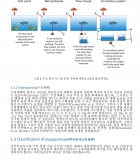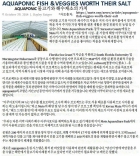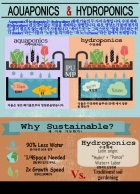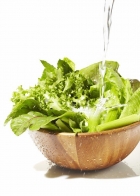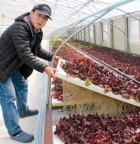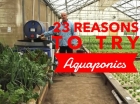 “ 아쿠아포닉과 도시농업 발전<미국> ”
“ 아쿠아포닉과 도시농업 발전<미국> ”
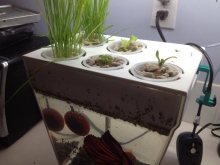
http://www.cbc.ca/news/technology/aquaponics-a-growing-trend-in-urban-agriculture-1.2534250
*아쿠아포닉이 도시농업을 키우는 추세라는 cbc 의 뉴스입니다.
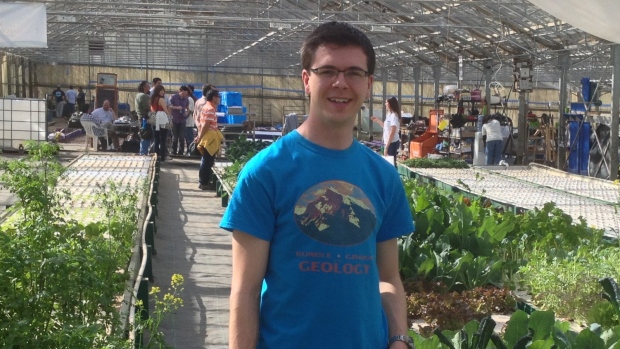
For most people, urban agriculture might mean a small vegetable garden in the backyard. But early adopters of aquaponics are taking things a step further, investing start-up costs of about $300 and using the food production system to grow vegetables and harvest fresh fish in their homes. Calgary-based Scott Weir, founder of Growing Gardeners Aquaponic and Urban Farms, travels the continent speaking about aquaponics. He calls it the merging of aquaculture — the raising of fish, usually edible fish — and hydroponics, or the soil-less growing of plants. "When you combine the two," he says, "you have a food producing system that's 95 per cent more efficient on water than traditional agriculture. You also have much higher density, and it's organic by nature." A small aquaponic unit in action. (Growing Gardeners/Facebook) The key to aquaponics lies in the water that the plants and fish share. The fish supply nutrients that feed the plants, and the plants clean the water so the fish can live in it. "So the fish...they poop into the water and produce waste. That waste is converted by micro-organisms into nitrogen and other minerals and nutrients," Weir explains. "The plants take that up, they clean that water for the fish, and then the clean water goes back to the fish." Tomatoes, cucumber, lettuce Aquaponics is a technique that goes back centuries, but with the current interest in local and organic food, it's being touted as a viable way to farm. Non-root vegetables, like tomatoes, cucumber and lettuce, can thrive in an aquaponic system, while edible fish, like tilapia, can be raised to be eaten in the same setup. It's an idea that's really starting catch on in North America — especially in the U.S., where large-scale commercial facilities have popped up in Chicago, Indiana and Delaware. And Weir says small-scale aquaponic setups are becoming more and common in people's homes. All you need is a fish tank, some fish, a small spot to grow your produce, some pumps to aid in the water exchange, and a pH monitor to make sure the water stays in balance. "One setup I had in my home...was producing enough food to feed me and one other person continually. So being able to grow a large part of your own food in your home or garage or whatever is a big deal, and it can reduce the cost of food as well, especially if you're comparing it to buying organic," Weir says. With interest in aquaponics on the rise, Weir has done some consulting for an up-and-coming large-scale aquaponics facility in Ontario and a few smaller, privately owned operations in Alberta. But those facilities are already running into some unexpected setbacks. Provincial law in Alberta states you have to get a commercial fishing license to use any fish — even common goldfish — for farming purposes, even in your own home. Before getting too far into your own aquaponics setup, Weir suggests checking with your local provincial fisheries branch first.
**구글번역판 입니다. 참고만 하세요.
대부분의 사람들에게, 도시 농업은 뒤뜰에있는 작은 채소밭을 의미 할 수 있습니다. 그러나 aquaponics의 얼리 어댑터가 한 단계 더 일을 복용하고, 약 $ 300 초기 비용을 투자하고 야채를 성장하고 자신의 집에서 신선한 생선을 수확하기 위해 식량 생산 시스템을 사용. 캘거리 기반 스콧 위어, 정원사 Aquaponic 및 도시 농장을 성장의 설립자, aquaponics에 대해 말하기 대륙을 여행한다. 물고기의 사육, 일반적으로 식용 물고기 - - 그리고 수경, 또는 식물의 토양없는 성장 그는에게 양식의 병합을 호출합니다. "당신이이 결합하면,"그는 "당신이 95 % 전통적인 농업보다 물에 더 효율적 식품 생산 시스템을 가지고있다. 또한 훨씬 더 높은 밀도를 가지고 있고, 그것은 자연에 의해 유기이다"라고 말한다. 행동에 작은 aquaponic 장치. aquaponics의 핵심은 물 식물과 물고기 주에있다 (정원사 / 페이스 북 성장). 물고기가 살 수 있도록 식물을 먹이 물고기 공급 영양소 및 식물은 물을 청소합니다. "물고기 그래서 ... 그들이 물에 똥과 폐기물을 생산하고 있습니다. 즉, 폐기물 질소 및 기타 미네랄과 영양소에 미생물에 의해 변환되어,"위어는 설명한다. "식물이 그를 차지, 그들은 물고기를 물 청소 한 다음 깨끗한 물은 물고기로 돌아갑니다." 토마토, 오이, 양상추, Aquaponics 세기를 거슬러 올라갑니다 기술이지만, 지역 및 유기농 식품의 현재 관심을 가지고, 그것은 농장에 실행 가능한 방법으로 선전되고 있어요. 틸라피아와 같은 식용 물고기, 같은 설정에서 먹을 수 제기 될 수있는 반면 비 루트 야채, 토마토, 오이, 상추처럼, aquaponic 시스템에서 번창 할 수 있습니다. 특히 대규모 상업 시설은 시카고, 인디애나와 델라웨어에서 팝업 한 미국에 - 정말 북미에 캐치를 시작하고 아이디어입니다. 그리고 위어 소규모 aquaponic 설정 사람들의 가정에 점점 더 일반화되고 있다고 말했습니다. 당신이 필요로하는 물고기 탱크, 일부 물고기, 당신의 농산물을 재배 할 수있는 작은 장소, 물 교환에 도움이 일부 펌프 및 균형 물 숙박 있는지 확인하기 위해 pH를 모니터입니다. "나는 내 집에 있었다 하나 설치 ... 그래서 집이나 차고 또는 어떤에서 자신의 음식의 많은 부분을 확장 할 수있는. 계속 저를 공급하기에 충분한 음식과 다른 한 사람을 생산 한 것은 큰 문제이며, 당신이 유기 구입과 비교하고, 특히뿐만 아니라 음식의 비용을 절감 할 수있다 "위어는 말한다. 상승에 aquaponics에 대한 관심과 함께, 위어 온타리오에서 떠오르는 대규모 aquaponics 시설과 알버타 작은, 개인 소유의 작업 몇 가지에 대한 몇 가지 컨설팅을하고있다. 하지만 그 시설은 이미 예상치 못한 난관에 실행하고 있습니다. 심지어 자신의 가정에서, 농업 목적으로 - 심지어 일반적인 금붕어 - 알버타 주정부 법은 당신이 어떤 물고기를 사용하기 위해 상업 낚시 면허증을 취득해야 말한다. 너무 멀리 자신의 aquaponics 설정에 점점 전에 위어 먼저 해당 지역의 지방 수산 분기와 검사를 제안한다.
|













 아쿠아포닉 뉴스
아쿠아포닉 뉴스





 전체글 보기
전체글 보기 
 전체글 보기
전체글 보기






 aquaponicsystem.jpg
aquaponicsystem.jpg













